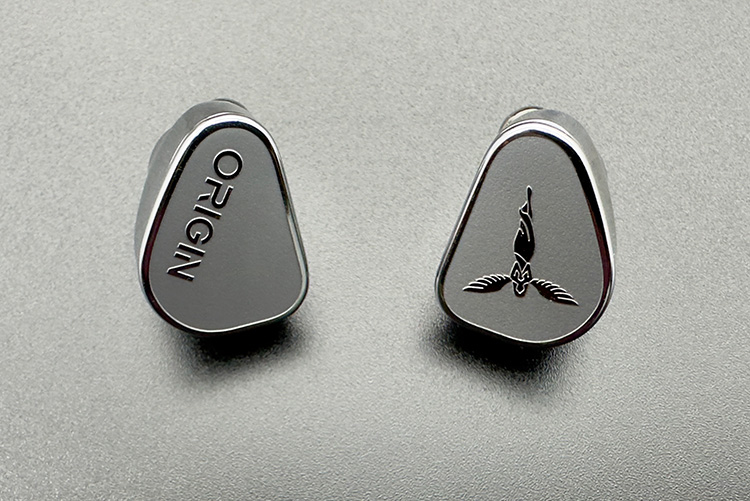Synergy
Origin has an impedance of 16Ω @1kHz and a sensitivity rating of 126 dB/Vrms making it easy to drive.
These IEMs pair best with a warmer source. Devices like smartphones, including the Apple iPhone, can drive them. I did find turning up the volume level a few levels higher than normal. Also, a good and powerful source, such as Lotoo Paw Gold Touch, notably enhances sound quality.
On a few occasions, I tested these IEMs with the Earmen Angel, an even more powerful source, and observed no noticeable hiss or static noise. The background is clean and silent.
Select Comparisons
SIMGOT EA1000
Technical
The SIMGOT EA1000 “Fermat” is a single 10mm dynamic driver IEM with a 6mm passive radiator. There are a lot of similarities between the EA1000 and Origin – from design to how they both sound.
It has an impedance of 16Ω and a sensitivity of 127 dB @1kHz/Vrms which makes it an efficient IEM, even with low power input. Compared to Origin, the EA1000 is easier to drive.
The EA1000 comes in three different tuning nozzles, which mostly alter the signature in the upper frequencies.
The difference in sound signature is mostly noticeable in how bright they sound, unlike Origin, where all the nozzles sound nearly the same.
Design
Origin and EA1000 have a similar design philosophy. The EA1000 is also an all-metal solidly built IEM. It is bigger and has a similar weight as Origin. The nozzle is short and wide compared to Origin.
The included cable is of decent quality and comes with a single-ended 3.5mm plug, just like Origin. In terms of design and fit, Origin has an edge here. The longer nozzle on Origin gives better insertion and fit.
Performance
Bass on the EA1000 has a better response, just by a small margin. The quantity of bass is higher on the EA1000. The reverberating nature of the bass on the EA1000 gives it a more natural feel, thus the edge. Origin’s bass has a faster decay.
In the mids department, EA1000 performs nearly the same as Origin. Origin has more forward mids. The resolution and sweetness of the midrange are very similar on both of these pairs, with an edge to the EA1000.
A similar story goes with the treble. Both of these pairs have a good amount of energy in the upper-frequency region. EA1000 is on the brighter side.
In terms of soundstage, Origin has an edge due to its spacious and airy sound. The EA1000 has more of an intimate soundstage. Both pairs have similar imaging quality.
In terms of sound, these two pairs are equally competent. It would just be a matter of preference. If someone’s preference leans towards heavy bass, the EA1000 is my preferred choice.
DUNU Falcon Ultra
Technical
The DUNU Falcon Ultra is a single dynamic driver iem with a Lithium-Magnesium alloy diaphragm and an upgraded architecture over the previous generation.
It has an impedance of 16Ω and a sensitivity of 108 dB @ 1kHz/Vrms. The Falcon Ultra is easy to drive and does not ask for plenty of power.
Like Origin, these IEMs also come with two interchangeable nozzles – one stainless steel and the other a gold-plated brass nozzle.
The stainless-steel nozzle is tuned to have a brighter signature with some extra energy in the upper mids and treble regions. The gold nozzle has a balanced tuning with a touch of warmth and less energy in the upper frequencies compared to the other nozzle. I prefer the gold nozzle on the Falcon Ultra.
Design
The Falcon Ultra shells have an all-metal body and come in an attractive deep blue color. The shells are on the smaller side and have a good fit. They weigh nearly the same as Origin.
The Falcon Ultra stock cable is a 4-core Silver-Plated copper Litz cable. The cable connection on the Falcon Ultra is MMCX, and the cable is modular. It comes in three different adapters – 3.5mm, 4.4mm and 6.5mm. This cable is quite ahead in terms of quality and build compared to the cable on Origin.
Performance
In terms of bass, I would rate these two IEMs very close. The sub-bass presence on the Falcon Ultra (on both the nozzles) is more pronounced than on the Origin. The bass quantity is a bit higher with the Falcon Ultra.
The midrange again performs similarly throughout the frequency range on both of these iems. The upper mids on Falcon Ultra (the gold nozzle) have less energy. The lower mids have more tonal weight on Falcon Ultra. The mids on Origin may be thinner by a very small margin.
In the treble region, Origin has more extension and does not have any unwanted peakiness, which the Falcon Ultra (on the blue nozzle) occasionally exhibits. With the gold nozzle, the Falcon Ultra has a balanced nature, and the treble is tamed a bit.
On the technical front, Origin has a wider soundstage and more open sound because of the way it has been designed. Other than that, these two don’t differ much in other aspects.
Oriveti OD200
Technical
The ORIVETI OD200 is a custom-tuned beryllium-coated 9.8mm single dynamic driver iem. It has an impedance of 16Ω and a sensitivity of 108 dB @1kHz/Vrms. The OD200 is easier to drive than the Origin. It can hiss or produce static noise when paired with powerful sources.
Like the Origin, these IEMs also come with interchangeable nozzle filters, black and silver. The silver nozzle adds a bit to the lower and mid-bass, and the treble is less sharp on it compared to the black nozzle.
Design
The OD200 has an all-metal body that is small and lightweight. Origin has smaller shells and more weight. OD200 does not have any fit issues owing to its universal design.
The cable that comes with OD200 is a modular cable with both 3.5mm and 4.4mm terminations. The quality of this cable is better than the one that comes with Origin.
Performance
The OD200 has a thick bass texture with some midbass boost. OD200 has more bass quantity, but the quality is much better and more appealing on Origin. There is some bass bleeding into the midrange.
In terms of midrange, OD200 is as forward as Origin, but there is more weight to the notes. The clarity and resolution in the midrange are better on Origin.
The treble on OD200 has less energy and airiness. Origin has more details in the upper frequency compared to the veiled and dark nature of OD200.
The Origin is ahead with a better soundstage and imaging. There is more openness to its sound and better resolution than OD200, which makes it more enjoyable between both IEMs.
Our Verdict
We have seen quite good releases in the single dynamic driver space in the past few years. In the current market, there is some good competition from IEMs such as Simgot’s EA1000, Oriveti OD200, and the DUNU Falcon Ultra.
Tanchjim has released quite a decent pair in Origin, which not only holds a strong position among the other IEMs but also sets a benchmark for soundstage and technical capabilities. With a very sleek design language, good tuning, and a decent price tag, Origin is an easy recommendation.
Tanchjim Origin Specifications
- Driver: DMT 5th Generation Dynamic Driver
- Impedance: 16Ω±5%.
- Sensitivity: 126dB/Vrms.
- THD+N: <0.056%.
- Frequency Response Range: 2-48kHz.
- Connector Type: 0.78mm 2-pin.
- Termination Plug: 3.5mm Single-Ended Termination.





